Prevalence of Rotavirus-Associated Acute Gastroenteritis Cases in Early Childhood in Turkey: Meta-Analysis
Abstract
1. Introduction
2. Methods
2.1. Systematic-Review Registration
2.2. Search Strategy and Screening
2.3. Study Selection
2.4. Inclusion Criteria
2.5. Exclusion Criteria
2.6. Quality Assessment
2.7. Data Extraction and Definitions
2.8. Meta-Analysis
3. Results
3.1. Description of Individual Studies
3.2. Prevalence of Rotavirus Infection among Children under Five
3.3. Seasonal Distribution of Rotavirus Infection
3.4. Meta-Analysis Results
4. Discussion
Study Limitations
5. Conclusions
Author Contributions
Funding
Conflicts of Interest
References
- GBD Diarrhoeal Diseases Collaborators. Estimates of global, regional, and national morbidity, mortality, and aetiologies of diarrhoeal diseases: A systematic analysis for the Global Burden of Disease Study 2015. Lancet Infect. Dis. 2017, 17, 909–948. [Google Scholar] [CrossRef]
- Wazny, K.; Zipursky, A.; Black, R.; Curtis, V.; Duggan, C.; Guerrant, R.; Sherman, P.M. Setting research priorities to reduce mortality and morbidity of childhood diarrhoeal disease in the next 15 years. PLoS Med. 2013, 10, e1001446. [Google Scholar] [CrossRef] [PubMed]
- Wang, H.; Naghavi, M.; Allen, C. Global, regional, and national life expectancy, all-cause mortality, and cause-specific mortality for 249 causes of death, 1980–2015: A systematic analysis for the Global Burden of disease study 2015. Lancet 2016, 388, 1459–1544. [Google Scholar] [CrossRef]
- Leung, D.T.; Chisti, M.J.; Pavia, A.T. Prevention and control of childhood pneumonia and diarrhea. Pediatric Clin. 2016, 63, 67–79. [Google Scholar] [CrossRef]
- Badur, S.; Öztürk, S.; Pereir, P.; Abdel Ghany, M.; Khalaf, M.; Lagoubi, Y.; Ozudogru, O.; Hanif, K.; Saha, D. Systematic review of the rotavirus infection burden in the WHO-EMRO region. Hum. Vaccines Immunother. 2019, 15, 2754–2768. [Google Scholar] [CrossRef]
- Troeger, C.; Khalil, I.A.; Rao, P.C.; Cao, S.; Blacker, B.F.; Ahmed, T.; Kang, G. Rotavirus vaccination and the global burden of rotavirus diarrhea among children younger than 5 years. JAMA Pediatr. 2018, 172, 958–965. [Google Scholar] [CrossRef]
- Balduzzi, S.; Rücker, G.; Schwarzer, G. How to perform a meta-analysis with R: A practical tutorial. Evid. Based Ment. Health 2019, 22, 153–160. [Google Scholar] [CrossRef]
- Akan, H.; İzbırak, G.; Gürol, Y.; Sarıkaya, S.; Gündüz, S.T.; Yılmaz, G.; Hayran, O.; Vitrinel, A. Rotavirus and adenovirus frequency among patients with acute gastroenteritis and their relationship to clinical parameters: A retrospective study in Turkey. Asia Pac. Fam. Med. 2009, 8, 8. [Google Scholar] [CrossRef]
- Akpınar, O.; Akpınar, H.; Keskin, E.Ş. Investigation of group a rotavirus antigen frequency in children who have acute gastroenteritis with immunochromatographic methods. J. DU Health Sci. Inst. 2017, 7, 78–81. [Google Scholar]
- Aslantaş, M.; Kılıçaslan, Ö.; Engin, M.; Büyük, N.; Yalçın, G.; Ankaralı, H.; Kocabay, K. Prevalence of rotavirus and adenovirus in children with acute gastroenteritis: A tertiary care hospital data. Fam. Pract. Palliat. Care 2017, 3, 1–5. [Google Scholar] [CrossRef]
- Atalay, M.A.; Kandemir, İ.; Gökahmetoğlu, S. Frequency of rotavirus infection in children with gastroenteritis in a tertiary hospital. Dicle Med. J. 2013, 40, 212–215. [Google Scholar] [CrossRef]
- Yasemin, I.; Balcı, I.; Polat, Y.; Çövüt, İ.E.; Canural, R.; Görüşen, İ.; Sarı, F. Frequency of rotavirus and adenovirus types 40/41 in children with gastroenteritis between 0–5 years of age in Denizli. Yeni Tıp Derg. 2010, 27, 15–17. [Google Scholar]
- Biçer, S.; Sahin, G.T.; Koncay, B.; Gemici, H.; Siraneci, R.; Ozturk, N.Y.; Sevketoğlu, E. Incidence assessment of rotavirus and adenovirus associated acute gastroenteritis cases in early childhood. Infez. Med. 2011, 19, 113–119. [Google Scholar] [PubMed]
- Borsa, B.A.; Tokman, H.B.; Çağatay, P. Determination of rotavirus and adenovirus frequency. Ankem Derg. 2013, 27, 75–79. [Google Scholar] [CrossRef]
- Çoban, B.; Topal, B. Evaluation of rotavirus gastroenteritis in children: Five years surveillance in Alanya, Antalya. Turk. J. Pediatr. 2014, 56, 280–284. [Google Scholar] [PubMed]
- Doğan, Y.; Ekşi, F.; Karslıgil, T.; Bayram, A. The investigation of the presence of rotavirus and adenovirus in patients with acute gastroenteritis. Türk. Mikrobiyol. Cem. Derg. 2014, 44, 18–22. [Google Scholar]
- Gül, M.; Garipardıç, M.; Çıragil, P.; Aral, M.; Karabiber, H.; Güler, L. Investigation of rotavirus and adenovirus types 40/41 in children with gastroenteritis between 0–5 years of age. Ankem Derg. 2005, 19, 64–67. [Google Scholar]
- Gültepe, B.; Yaman, G.; Çıkman, A.; Güdücüoğlu, H. The frequency of rotavirus and adenovirus among childhood gastroenteritis. Türk. Mikrobiyol. Cem. Derg. 2012, 42, 16–20. [Google Scholar]
- Güreser, A.S.; Karasartova, D.; Taşçı, L.; Özkan, T.H.A. Rotavirus and adenovirus frequency in children with acute gastroenteritis in corum. Flora 2017, 22, 58–66. [Google Scholar] [CrossRef]
- Iraz, M.; Ceylan, A. Frequency of rotavirus in children with acute gastroenteritis between 0–5 years of age. Ankem Derg. 2013, 27, 2–6. [Google Scholar] [CrossRef]
- İlktaç, M.; Şahin, A.; Nazik, H.; Ongen, B. Investigation of rotavirus frequency and following up the rotavirus season among children with acute gastroenteritis: Evaluation of five-year results. Ankem Derg. 2012, 26, 25–29. [Google Scholar] [CrossRef]
- Kaşifoğlu, N.; Us, T.; Aslan, F.G.; Akgün, Y. The rate of rotavirus antigen positivity during 2005–2011. Türk Mikrobiyol. Cem. Derg. 2011, 41, 111–115. [Google Scholar]
- Kurugol, Z.; Geylani, S.; Karaca, Y.; Umay, F.; Erensoy, S.; Vardar, F.; Ozkinay, C. Rotavirus gastroenteritis among children under five years of age in Izmir, Turkey. Turk. J. Pediatr. 2003, 45, 290–294. [Google Scholar] [PubMed]
- Otağ, F.; Direkel, Ş.; Özgür, D.; Delialioğlu, N.; Aslan, G.; Emekdaş, G. Investigation of rotavirus and enteric adenovirus in pediatric patients with acute gastroenteritis by rapid immunochromatographic methods. Mersin Univ. Saglık. Bilim. Derg. 2012, 11, 18–23. [Google Scholar]
- Özdemir, S.; Delialioğlu, N.; Emekdaş, G. Investigatıon of rotavirus, adenovirus and astrovirus frequencies in children with acute gastroenteritis and evaluation of epidemiological features. Mikrobiyol. Bull. 2010, 44, 571–578. [Google Scholar]
- Şanal, L. Determination of rotavirus and adenovirus frequency in children with gastroenteritis between 0–5 years of age. Ortadogu Med. J. 2013, 5, 73–77. [Google Scholar]
- Dağı, H.T.; Fındık, D. Investigation of rotavirus and adenovirus antigens in patients with acute gastroenteritis. J. Clin. Exp. Investig. 2014, 5, 256–260. [Google Scholar] [CrossRef]
- Tüzüner, U.; Gülcen, B.S.; Özdemir, M.; Feyzioglu, B. Frequency of adenovirus and rotavirus and their seasonal distribution in children with gastroenteritis. Klimik Derg. 2016, 29, 121–124. [Google Scholar] [CrossRef]
- Yazıcı, V.; Manzur, Y.; Akbulut, A. Investigation of rotavirus and enteric adenovirus infection frequency in cases with acute gastroenteritis. Klimik Derg. 2013, 26, 13–16. [Google Scholar] [CrossRef]
- Alaşehir, E.A.; Balıkcı, A.; Topkaya, A.E. Rotavirus antigen positivity in children with acute gastroenteritis and its relationship with demographic data. Ankem Derg. 2014, 28, 41–43. [Google Scholar] [CrossRef]
- Balkan, Ç.E.; Çelebi, D.; Çelebi, Ö.; Altoparlak, Ü. Investigation of rotavirus and adenovirus frequency among 0–5 years old children with acute gastroenteritis in Erzurum. Türk Mikrobiyol. Cem. Derg. 2012, 42, 51–54. [Google Scholar]
- Bayraktar, B.; Toksoy, B.; Bulut, E. Detection of rotavirus and adenovirus in children with acute gastroenteritis. Klimik Derg. 2010, 23, 15–17. [Google Scholar] [CrossRef]
- Bekdaş, M.; Demircioğlu, F.; Göksügür, S.B.; Küçükbayrak, B.; Kısmet, E. Acute gastroenteritis during childhood in Bolu, Turkey: 3 years of experience. GJMEDPH 2013, 2, 1–7. [Google Scholar]
- Berk, E.; Kayman, T. Frequency of rotavirus in children with acute gastroenteritis. Ankem Derg. 2011, 25, 103–106. [Google Scholar] [CrossRef]
- Ayşe, I. The frequency of rotavirus in children with acute gastroenteritis. J. Clin. Anal. Med. 2015, 6, 449–451. [Google Scholar]
- İnci, A.; Kurtoğlu, M.G.; Baysal, B. Investıgatıon of the prevalence of rotavirus gastroenterıtıs ın an educational and research hospıtal. Turk. J. Infect. 2009, 23, 79–82. [Google Scholar]
- İrvem, A.; Yücel, F.M.; Yıldırım, M.; Kadanalı, A.; Dede, B. Frequency of rotavirus in children with acute gastroenteritis. Türk Mikrobiyol. Cem. Derg. 2014, 44, 98–100. [Google Scholar] [CrossRef]
- Kızılırmak, A.; Çalışkan, E.; Temizkan, R.C. Frequency in children with acute gastroenteritis. Konuralp Tıp Derg. 2017, 9, 35–39. [Google Scholar] [CrossRef]
- Çalgın, M.K.; Çetinkol, Y.; Yıldırım, A.A.; Erdil, A.; Dağlı, A. Investigation of rotavirus and enteric adenovirus frequency among children with acute gastroenteritis in ordu. Ankem Derg. 2015, 29, 59–65. [Google Scholar] [CrossRef]
- Konca, Ç.; Tekin, M.; Akgün, S.; Bülbül, M.; Çoban, M.; Kahramaner, Z.; Turgut, M. Prevalence of rotavirus in children with acute gastroenteritis, seasonal distribution, and laboratory findings in the southeast of Turkey. J. Pediatr. Inf. 2014, 8, 7–11. [Google Scholar] [CrossRef]
- Nazik, S.; Sezer, A.; Duran, İ. Rotavirus and adenovirus incidences in diarrheas existing in the early childhood. Flora 2016, 21, 10–14. [Google Scholar]
- Oğuz, S.; Kurt, F.; Tekin, D.; Kocabas, B.A.; Ince, E.; Suskan, E. Burden of rotavirus gastroenteritis in the pediatric emergency service. J. Pediatr. Inf. 2014, 8, 99–104. [Google Scholar] [CrossRef]
- Şafak, B. The frequency of rotavirus and adenovirus ın pedıatrıc patıents wıth acute gastroenterıtıs. ACU Sağlık Bil. Derg. 2014, 2, 121–124. [Google Scholar]
- Tanrıverdi, Ç.Y.; Yılmaz, G.; Birinci, A. Investigation of the frequency of rotavirus and adenovirus in acute gastroenteritis cases. Pamukkale Tıp Derg. 2017, 1, 61–65. [Google Scholar] [CrossRef]
- Tekin, A. The frequency of rotavirus and enteric adenovirus in children with acute gastroenteritis in Mardin. J. Clin. Exp. Investig. 2010, 1, 43–45. [Google Scholar] [CrossRef]
- Gönüllü, E.; Soysal, A.; Yıldız, İ.; Karaböcüoğlu, M. Impact of self-financed rotavirus vaccination on acute gastroenteritis in young children in Turkey. Hum. Vaccinesand Immunother. 2020, 1–7. [Google Scholar] [CrossRef]
- Malek, M.A.; Teleb, N.; Abu, R.E.; Riddle, M.S.; Sherif, M.E.; Steele, A.D.; Bresee, J.S. The epidemiology of rotavirus diarrhea in countries in the Eastern Mediterranean Region. J. Infect. Dis. 2010, 202, 12–22. [Google Scholar] [CrossRef]
- Loharikar, A.; Dumolard, L.; Chu, S.; Hyde, T.; Goodman, T.; Mantel, C. Status of new vaccine introduction worldwide, september 2016. Morb. Mortal. Wkly. Rep. 2016, 65, 1136–1140. [Google Scholar] [CrossRef]
- Bányai, K.; Estes, M.K.; Martella, V. Parashar UD. Viral gastroenteritis. Lancet 2018, 392, 175–186. [Google Scholar] [CrossRef]
- Khoury, H.; Ogilvie, I.; El Khoury, A.C.; Duan, Y.; Goetghebeur, M.M. Burden of rotavirus gastroenteritis in the Middle Eastern and North African pediatric population. BMC Infect. Dis. 2011, 11, 9. [Google Scholar] [CrossRef]
- Procop, G.W. Gastrointestinal infections. Infect. Dis. Clin. N. Am. 2001, 15, 1073–1108. [Google Scholar] [CrossRef]
- Tapisiz, A.; Demirdag, B.T.; Cura, B.C.Y.; Gunes, C.; Ugraş, A.D.; Tezer, H.; Ozkan, S. Rotavirus infections in children in Turkey: A systematic review. Rev. Med. Virol. 2019, 291, e2020. [Google Scholar] [CrossRef] [PubMed]
- American Academy of Pediatrics; Subcommittee on Acute Gastroenteritis. Practice parameter: The management of acute gastroenteritis in young children. Paediatrics 1996, 97, 424–435. [Google Scholar]
- Amini, S.; Solati, A.A.; Fayaz, A.; Mahmoodi, M. Rotavirus infection in children with acute diarrhoea in Tehran. Med. J. Islam Repub. Iran 1990, 4, 25–28. [Google Scholar] [PubMed]
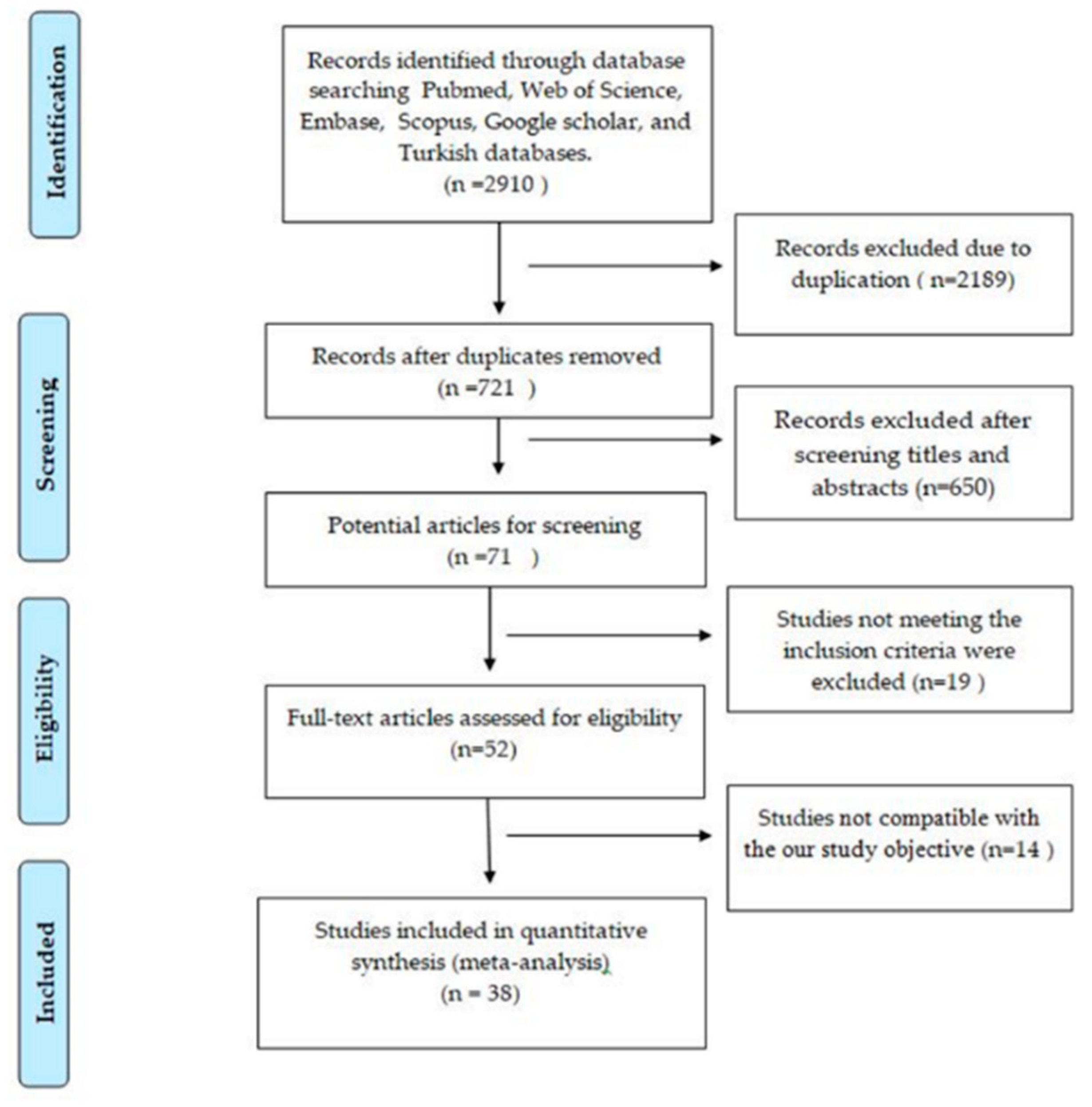
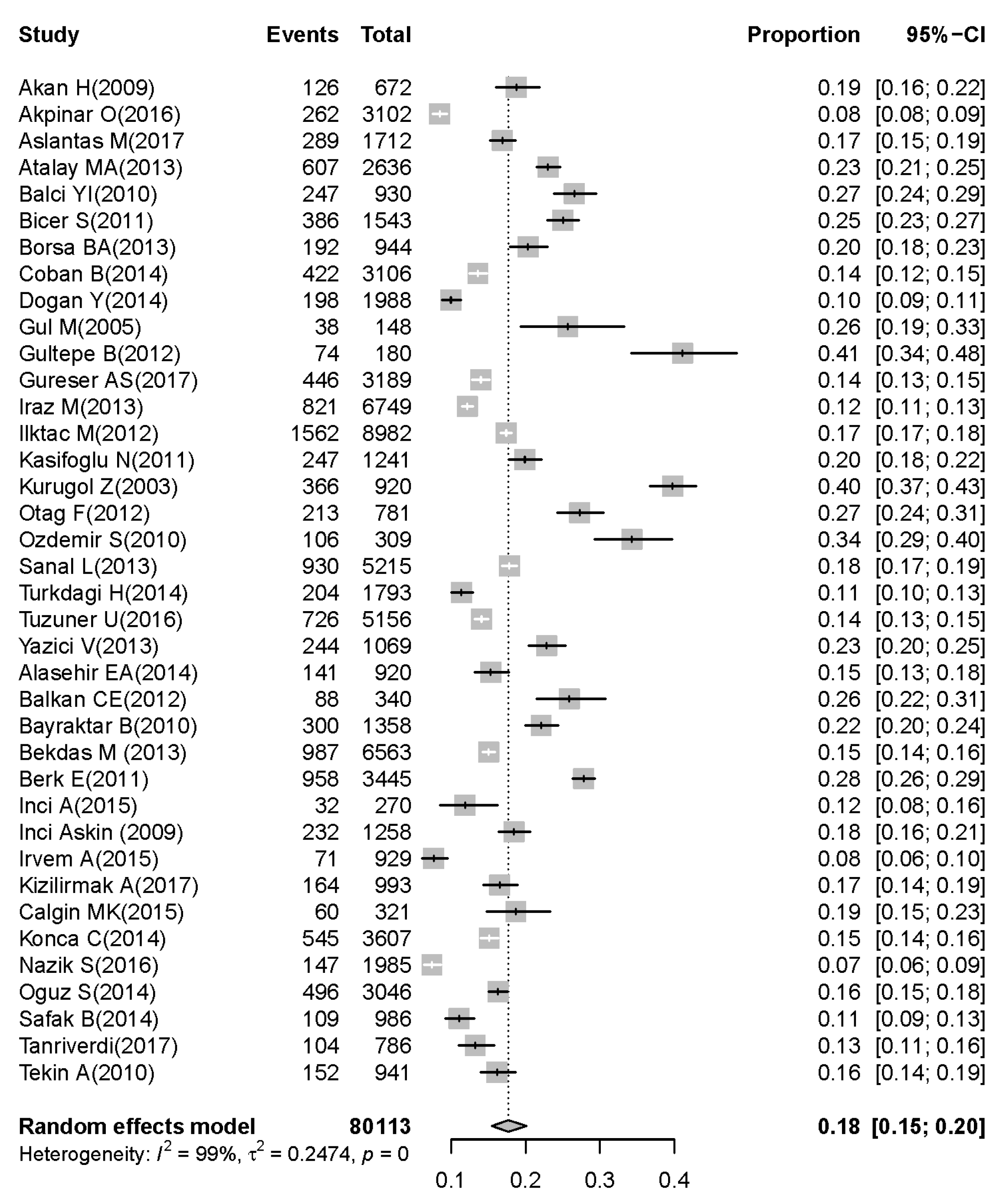
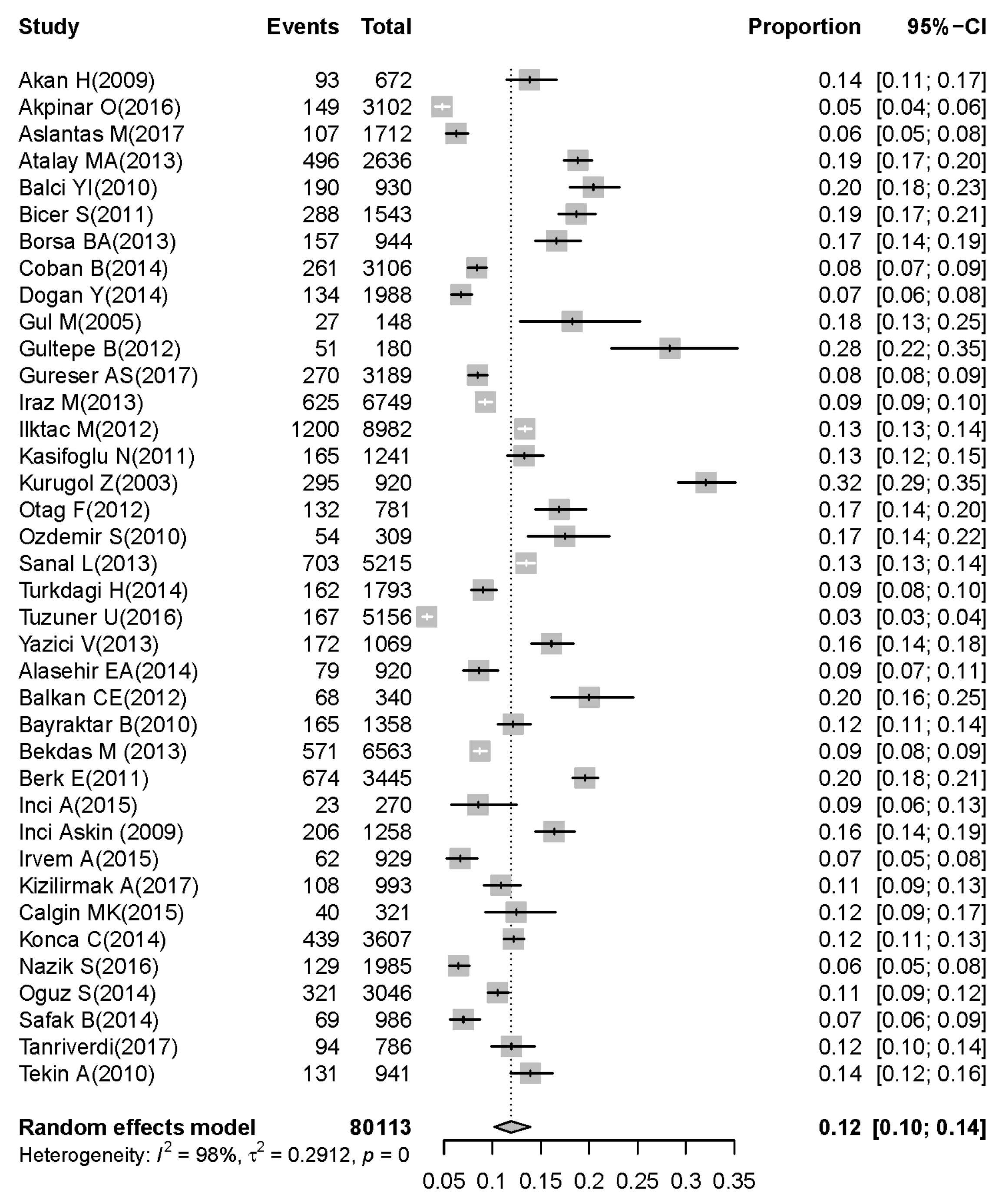
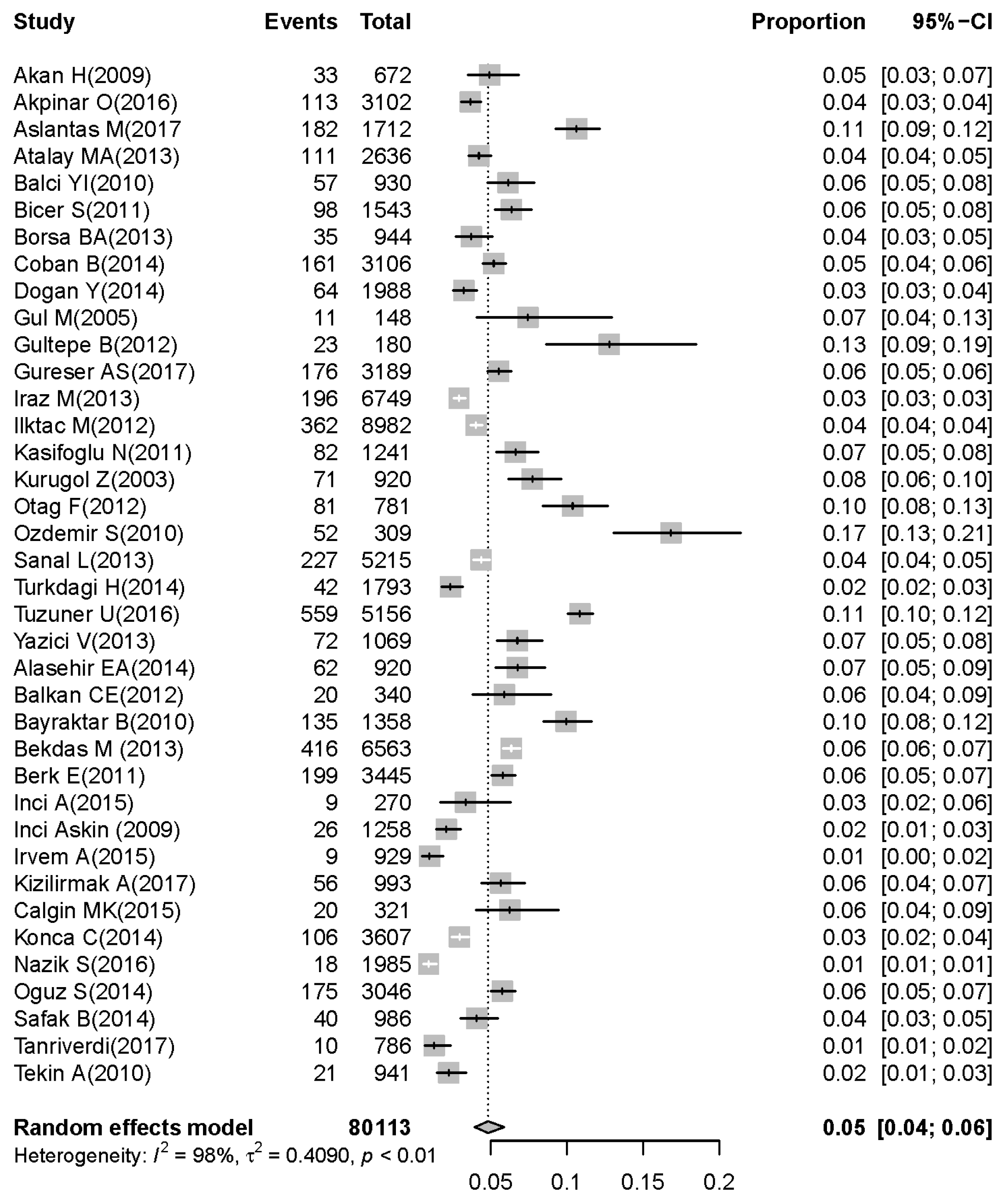
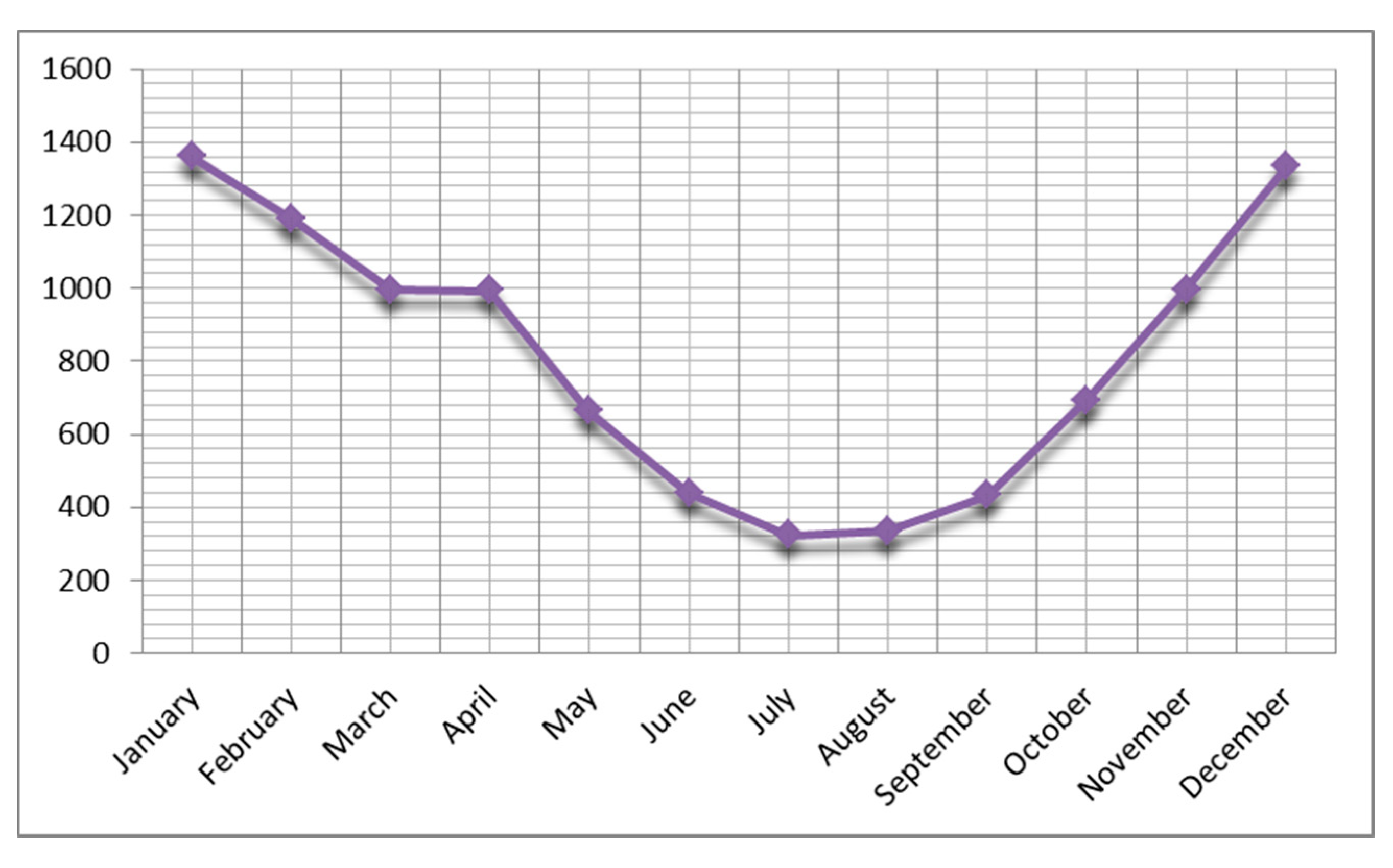
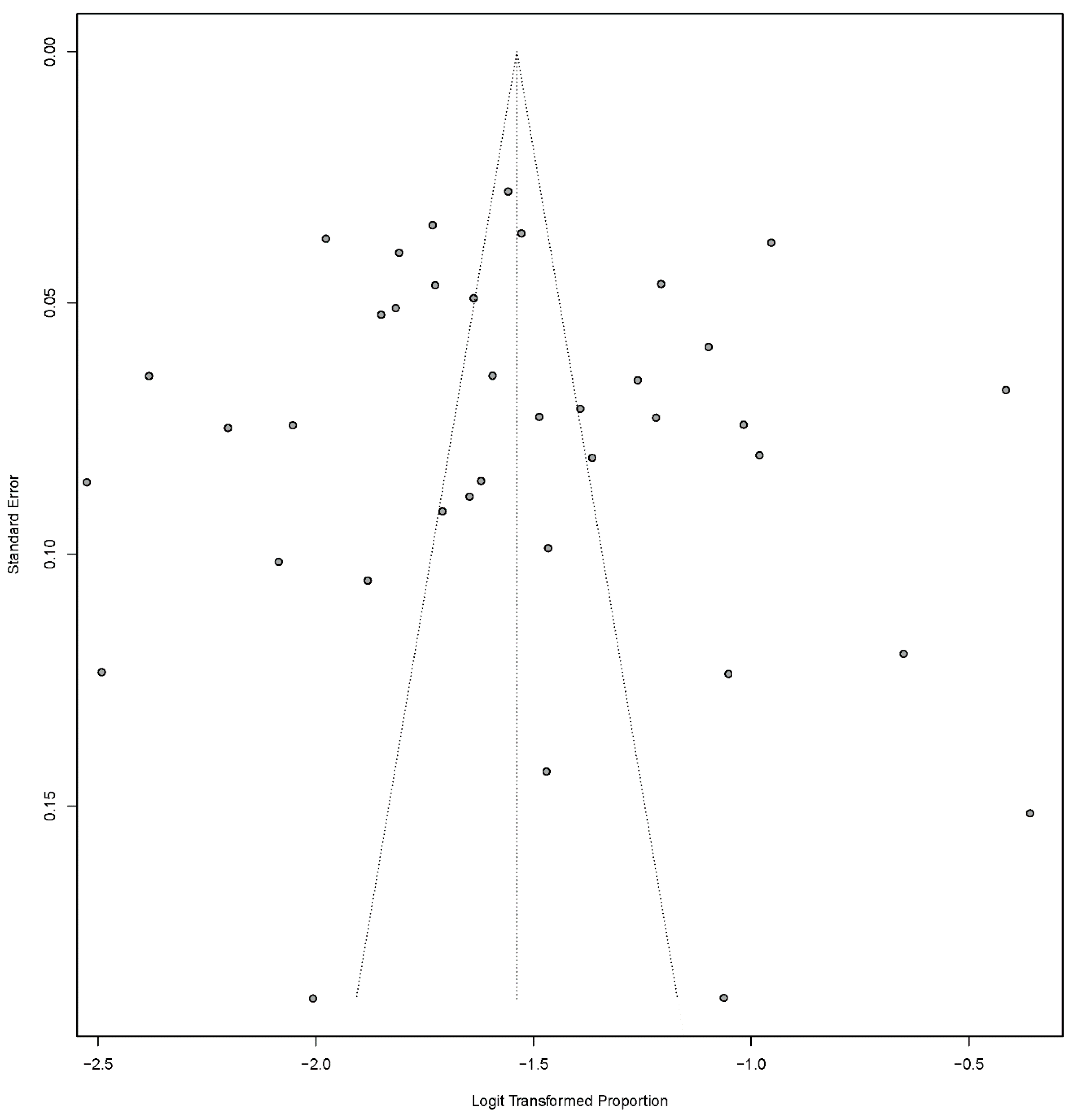
| No | First Author | Time of Study | Province | Total | Positive | Method | Ref. No |
|---|---|---|---|---|---|---|---|
| 1 | Akan H (2009) | 2007–2008 | İstanbul | 672 | 126 | IM | [8] |
| 2 | Akpınar O (2016) | 2013–2014 | Isparta | 3102 | 262 | IM | [9] |
| 3 | Aslantaş M (2017) | 2013–2016 | Düzce | 1712 | 289 | IM | [10] |
| 4 | Atalay MA (2013) | 2009–2012 | Kayseri | 2636 | 607 | IM | [11] |
| 5 | Balcı YI (2010) | 2008–2009 | Denizli | 930 | 247 | LA | [12] |
| 6 | Biçer S (2011) | 2007–2008 | İstanbul | 1543 | 386 | IM | [13] |
| 7 | Borsa BA (2013) | 2010–2011 | Mardin | 944 | 192 | IM | [14] |
| 8 | Çoban B (2014) | 2008–2013 | Antalya | 3106 | 422 | IM | [15] |
| 9 | Doğan Y (2014) | 2012–2013 | Gaziantep | 1988 | 198 | IM | [16] |
| 10 | Gül M (2005) | 2003–2004 | K.Maaraş | 148 | 38 | LA | [17] |
| 11 | Gültepe B (2012) | 2009–2009 | Van | 180 | 74 | LA | [18] |
| 12 | Güreser AS (2017) | 2013–2014 | Çorum | 3189 | 446 | IM | [19] |
| 13 | Iraz M (2013) | 2011–2012 | İstanbul | 6749 | 821 | IM | [20] |
| 14 | İlktaç M (2012) | 2006–2010 | İstanbul | 8982 | 1562 | IM | [21] |
| 15 | Kaşifoğlu N (2011) | 2005–2011 | Eskişehir | 1241 | 247 | ELISA | [22] |
| 16 | Kurugöl Z (2003) | 2000–2000 | İzmir | 920 | 366 | ELISA | [23] |
| 17 | Otağ F (2012) | 2009–2011 | Mersin | 781 | 213 | IM | [24] |
| 18 | Özdemir S (2010) | 2008–2008 | Mersin | 309 | 106 | ELISA | [25] |
| 19 | Şanal L (2013) | 2011–2011 | Ankara | 5215 | 930 | IM | [26] |
| 20 | Türkdağı H (2014) | 2010–2013 | Konya | 1793 | 204 | IM | [27] |
| 21 | Tüzüner U (2016) | 2013–2015 | Konya | 5156 | 726 | IM | [28] |
| 22 | Yazıcı V (2013) | 2009–2011 | Kocaeli | 1069 | 244 | IM | [29] |
| 23 | Alaşehir EA (2014) | 2010–2013 | İstanbul | 920 | 141 | IM | [30] |
| 24 | Balkan ÇE (2012) | 2010–2011 | Erzurum | 340 | 88 | IM | [31] |
| 25 | Bayraktar B (2010) | 2008–2009 | İstanbul | 1358 | 300 | IM | [32] |
| 26 | Bekdaş M (2013) | 2007–2009 | Bolu | 6563 | 987 | IM | [33] |
| 27 | Berk E (2011) | 2009–2011 | Kayseri | 3445 | 958 | IM | [34] |
| 28 | İnci A (2015) | 2010–2013 | Artvin | 270 | 32 | IM | [35] |
| 29 | İnci Aşkın (2009) | 2007–2008 | Konya | 1258 | 232 | IM | [36] |
| 30 | İrvem A (2015) | 2012–2013 | İstanbul | 929 | 71 | IM | [37] |
| 31 | KIızılırmak A (2017) | 2014–2015 | Düzce | 993 | 164 | IM | [38] |
| 32 | Çalgın MK (2015) | 2013– 2015 | Ordu | 321 | 60 | IM | [39] |
| 33 | Konca Ç (2014) | 2012–2013 | Adıyaman | 3607 | 545 | IM | [40] |
| 34 | Nazik S (2016) | 2011–2015 | Bingöl | 1985 | 147 | IM | [41] |
| 35 | Oğuz S (2014) | 2011–2012 | Ankara | 3046 | 496 | IM | [42] |
| 36 | Şafak B (2014) | 2011–2013 | Balıkesir | 986 | 109 | IM | [43] |
| 37 | Tanrıverdi (2017) | 2014–2015 | Samsun | 786 | 104 | IM | [44] |
| 38 | Tekin A (2010) | 2008–2009 | Mardin | 941 | 152 | IM | [45] |
© 2020 by the authors. Licensee MDPI, Basel, Switzerland. This article is an open access article distributed under the terms and conditions of the Creative Commons Attribution (CC BY) license (http://creativecommons.org/licenses/by/4.0/).
Share and Cite
Güzel, M.; Akpınar, O.; Kılıç, M.B. Prevalence of Rotavirus-Associated Acute Gastroenteritis Cases in Early Childhood in Turkey: Meta-Analysis. Children 2020, 7, 159. https://doi.org/10.3390/children7100159
Güzel M, Akpınar O, Kılıç MB. Prevalence of Rotavirus-Associated Acute Gastroenteritis Cases in Early Childhood in Turkey: Meta-Analysis. Children. 2020; 7(10):159. https://doi.org/10.3390/children7100159
Chicago/Turabian StyleGüzel, Mustafa, Orhan Akpınar, and Muhammet Burak Kılıç. 2020. "Prevalence of Rotavirus-Associated Acute Gastroenteritis Cases in Early Childhood in Turkey: Meta-Analysis" Children 7, no. 10: 159. https://doi.org/10.3390/children7100159
APA StyleGüzel, M., Akpınar, O., & Kılıç, M. B. (2020). Prevalence of Rotavirus-Associated Acute Gastroenteritis Cases in Early Childhood in Turkey: Meta-Analysis. Children, 7(10), 159. https://doi.org/10.3390/children7100159





